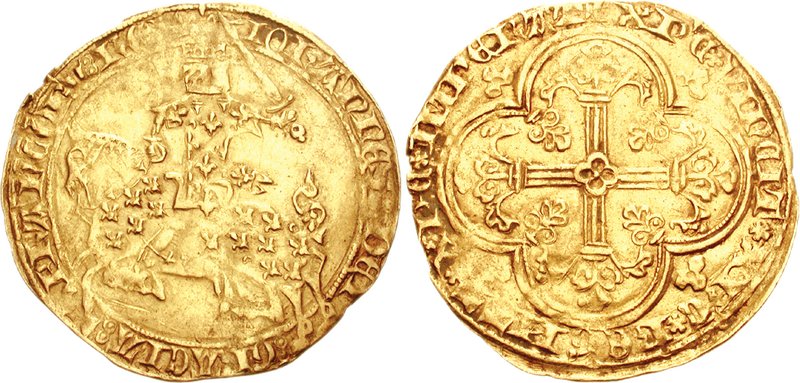- Livre tournois
The livre tournois ("
Tours pound") was:
#one of numerous currencies used inFrance in the Middle Ages; and
#a money of account (i.e., a monetary unit used in accounting) used in France in the Middle Ages and the early modern period.Circulating currency
Coin image box 1 double
header =John II of France
hbkg = #abcdef

caption_left = John, armored, on horseback left, holding sword. Around IOHANNES DEI GRATIA - FRANCORV REX
caption_right = Cross fleurée; lis in quarters; all within tressure; trefoils in angles; around + XP'C* VInCIT* XP'C* REGNAT* XP'C* INPERAT
width = 250
footer =Franc à cheval , 1360
position = right
margin = 0Coin image box 1 double
header =Charles V of France
hbkg = #abcdef
caption_left = Charles standing facing, holding sword, in Gothic arch flanked by lis; KAROLVS x DI x GR FRANCOR x REX ; there is an R at end of legend(La Rochelle mint)
caption_right = Ornate cross with trefoils at ends; lis and crowns in quarters; all within tressure; lis in angles. XPC* VINCIT x XRC REGNAT XRC* IMPERAT
width = 250
footer =Franc à pied
position = right
margin = 0The "denier tournois" coin was initially minted by the abbey of Saint Martin in theTouraine region of France. Soon afterPhilip II of France seized the counties ofAnjou andTouraine in 1203 and standardized the use of the "livre tournois" there, the livre tournois began to supersede the "livre parisis " (Paris pound) which had been up to that point the official currency of theCapetian dynasty .The livre tournois was, in common with the original livre of Charlemagne, divided into 20 "sols" ("sous" after 1715),Fact|date=February 2007 each of which was divided into 12 deniers.
Between 1360 and 1641, coins worth one livre tournois were minted, known as "francs" (the name coming from the inscription "Johannes Dei Gratia Francorum Rex", "Jean, by the grace of God, King of the French").Fact|date=February 2007 Other francs were minted under
Charles V of France , Henri III of France and Henri IV of France.Fact|date=February 2007 The use of the name "franc" became a synonym for livre tournois in accounting.The first French paper money, issued between 1701 and 1720, was denominated in livres tournois (see "Standard Catalog of World Paper Money", Albert Pick). This was the last time the name was used officially, as later notes and coins were denominated simply in livres, the
livre parisis having finally been abolished in 1667.Fact|date=February 2007Accounting currency
With many forms of domestic and international currency (with different weights, purities and quality) circulating throughout Europe in the late Middle Ages and the early modern period, the use of an "accounting currency" became a financial necessity. In the world of international banking of the 13th century, it was the
florin andducat which were often used. In France, the livre tournois and the currency system based on it became a standard monetary unit of accounting and continued to be used even when the "livre tournois" ceased to exist as an actual coin.The official use of the livre tournois accounting unit in all contracts in France was legislated in 1549, but it had been one of the standard units of accounting in France since the 13th century. In 1577 the livre tournois accounting unit was officially abolished and accountants switched to the
écu , which was at that time the major French gold coin in actual circulation, but in 1602 the livre tournois accounting unit was brought back. (A monetary unit of accounting based on the livre parisis continued to be used for minor uses in and around Paris and was not officially abolished until1667 by Louis XIV).Since coins in Europe in the Middle Ages and the Early modern period (the French écu, Louis,
teston d'argent ,denier , double,franc ; the Spanishdoubloon ,pistole , real; the Italianflorin ,ducat or sequin; the Germanthaler ; theDutch gulden , etc.) did not have any indication of their value, their official value was determined by royal edicts. In cases of financial need, French kings could use the official value forcurrency devaluation . This could be done in two ways: (1) the amount of precious metal in a newly minted French coin could be reduced while nevertheless maintaining the old value in livres tournois or (2) the official value of a domestic or foreign coin in circulation could be increased. By reversing these techniques, currencies could be reinforced.For example:
* the worth of an écu d'or, a French gold coin, was changed from 60 sols to 57 sols in 1573.
* to curb increasing use of theSpanish real , its official worth was decreased to 4 sols 2 deniers in the 1570s.Royal finance officers faced many difficulties. In addition to currency speculation, forgery and the intentional shaving of precious metal from coins (which was harshly punished), they had the difficult problem of setting values for gold, silver, copper and
billon coins, responding to the often large influx of foreign coin and the appearance of inferior foreign coins of intentionally similar design. For more on these issues, seeMonetary policy andGresham's Law .ee also
*
French livre
*Livre parisis (Paris pound)
*French franc
*Louis (coin)
*Luxembourgish livre
*Écu (coin)
*Roman currency
Wikimedia Foundation. 2010.

